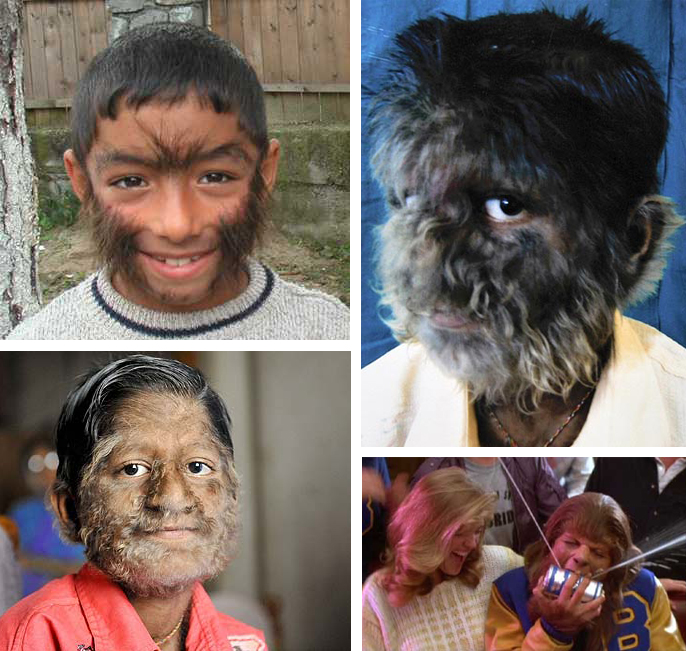10. Epidermodysplasia Verruciformis

Epidermodysplasia verruciformis (also called Lewandowsky-Lutz dysplasia or Lutz-Lewandowsky epidermodysplasia verruciformis) is an extremely rare autosomal recessive genetic hereditary skin disorder associated with a high risk of carcinoma of the skin. It is characterized by abnormal susceptibility to human papillomaviruses (HPVs) of the skin. The people resemble bark of trees .
9. Progeria

Progeria (also known as “Hutchinson–Gilford progeria syndrome” and “Hutchinson–Gilford syndrome”) is an extremely rare, severe, genetic condition wherein symptoms resembling aspects of aging are manifested at an early age. The disorder has a very low incidence and occurs in one per eight million live births. Those born with progeria typically live about thirteen years, although many have been known to live into their late teens and early twenties and rare individuals may even reach their forties. It is a genetic condition that occurs as a new mutation and is not usually inherited, although there is a uniquely inheritable form. This is in contrast to another rare but similar premature aging syndrome, dyskeratosis congenita (DKC), which is inheritable and will often be expressed multiple times in a family line.
It caused by a single gene affect in child’s genetic code resulting in hastening of normal aging process thus causing premature aging.
8. Aquagenic Urticaria

Aquagenic urticaria, also known as water allergy, the sufferer can’t go from a nice hot water bath or a shower or enjoy swimming, even sweating after a tiresome work brings a painful rash, it is an extremely rare form of physical urticaria. It is sometimes described as an allergy, although it is not a histamine releasing allergic reaction like other forms of urticaria; it is more a hypersensitivity to the ions found in non-distilled water. In affected persons, water on the skin causes hives to appear within 15 minutes and last for up to two hours. It is very unusual.
7. Alice in The Wonderland Syndrome (AIWS) Or Todd’s Syndrome:

Alice in Wonderland syndrome, also known as Todd’s syndrome, is a disorienting neurological condition which affects human perception. Sufferers may experience micropsia, macropsia, and/or size distortion of other sensory modalities. A temporary condition, it is often associated with migraines, brain tumors, and the use of psychoactive drugs
Micropsia is a neurological condition affecting human visual perception in which humans, inanimate and animate objects are perceived to be substantially smaller than they actually are. Micropsia can be caused by either optical distortion of images in the eye (as by glasses or certain ocular conditions) or by a neurological dysfunction. Similarly macropsia is the reverse condition characterized by objects appearing substantially larger than they actually are e.g a car may seem as big as a mountain.
6. Arnold Chiari Malformation

Arnold-Chiari malformation is a malformation of the brain. It consists of a downward displacement of the brain into the spinal cord. This boy Rhett Lamb is not oridinary in the fact he can’t sleep a wink. He has been awake for 4 years 24 hours a day. His condition has baffled the parents and the doctors who have finally came after a complicated discussion to the diagnosis of this young boy as Chiari Syndrome.
When it happens it can cause headaches,vomiting, muscle weakness in the head and face, difficulty swallowing,mental impairment,paralysis of arms, paralysis of legs, progressive brain impairment, involuntary eye movements – usually rapid and downward, dizziness, double vision, deafness, impaired coordination, and in some cases death.
5. Hypertrichosis (Werewolf Syndrome)

Hypertrichosis describes hair growth on the body in an amount which is considered abnormal. This is a very rare condition and described as human werewolves because the sufferer resembles much of werewolf except having sharp claws and teeth. There are two distinct types of hypertrichosis: generalized hypertrichosis, which occurs over the entire body, and localized hypertrichosis, which is restricted to a certain area. Hypertrichosis is either congenital (present at birth), or acquired later in life.
4. Dissociative Identity Disorder

Before the 19th century, people exhibiting symptoms of the disorder were believed to be possessed. An intense interest in spiritualism, parapsychology, and hypnosis continued throughout the 19th and early 20th centuries and may be even till today.
Dissociative identity disorder (DID) is a psychiatric diagnosis that describes a condition in which a person displays multiple distinct identities or personalities (known as alter egos or alters), each with its own pattern of perceiving and interacting with the environment. the name for this diagnosis is multiple personality disorder. Tthe diagnosis requires that at least two personalities routinely take control of the individual’s behavior with an associated memory loss that goes beyond normal forgetfulness.
3. Parasitic Twin (Fetus in Fetus)
The independent twin is called the autosite.

It is a exaggerated case of siamese twins. Two twins don´t get to separate completely when they are zygotes and they are united by some zone. One of these twins grows healthy whereas the other degenerates, remaining inside the healthy twin and depending completely on him. It is unkown why these twins don´t separate correctly. Unlike conjoined twins, one ceases development during gestation and is vestigial to a mostly fully-formed, otherwise healthy individual twin. The undeveloped twin is defined as parasitic, rather than conjoined, because it is incompletely formed or wholly dependent on the body functions of the complete fetus.
2. Persistent Sexual Arousal Disorder

Persistent Genital Arousal Disorder (PGAD), also known as Restless Genital Syndrome (ReGS or RGS)[, results in a spontaneous and persistent genital arousal, with or without orgasm or genital engorgement, unrelated to any feelings of sexual desire. Some physicians use the term Persistent Sexual Arousal Syndrome to refer to the condition in women; others consider the syndrome of priapism in men to be the same disorder. In addition to being very rare, the condition is also frequently unreported by sufferers who may consider it shameful or embarrassing.
Physical arousal caused by this syndrome can be very intense and persist for extended periods, days or weeks at a time. Orgasm can sometimes provide temporary relief, but within hours the symptoms return. The symptoms can be debilitating, preventing concentration on mundane tasks. Some situations, such as riding in an automobile or train, vibrations from mobile phones, and even going to the toilet can aggravate the syndrome unbearably. A person can orgasm upto 200 times a day. UK’s Sarah Carmen is a 200-orgasm-a-day-girl.
1. Polymelia

Polymelia is a birth defect involving limbs, in which the affected individual has more than the usual number of limbs. In humans and most land-dwelling animals, this means having five or more limbs. The extra limb is most commonly shrunken and/or deformed.
Sometimes an embryo started as conjoined twins, but one twin degenerated completely except for one or more limbs, which end up attached to the other twin. Sometimes small extra legs between the normal legs are caused by the body axis forking.